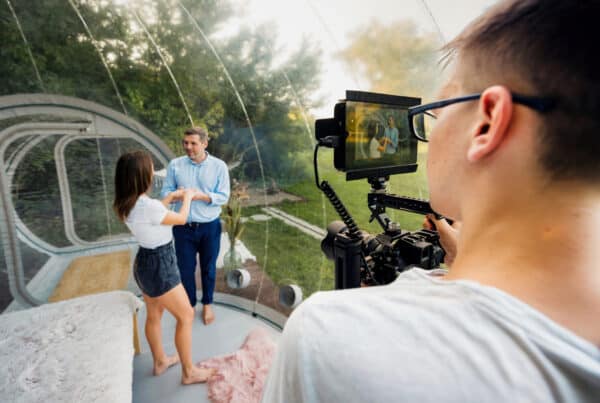What Is 360 Video Production?
360-degree video production, also known as immersive video creation or spherical video production, involves capturing footage in a way that allows viewers to look around in all directions. This format gives the audience the ability to control their perspective, immersing them in the video as if they were physically present in the environment. Unlike traditional video production, where the viewer’s perspective is fixed, 360 videos provide a more dynamic and interactive experience.
Table of Contents
ToggleThe production process for 360 videos involves specialized equipment, editing techniques, and distribution strategies that differ significantly from traditional video production. The goal is to create content that is not only engaging but also informative and emotionally compelling.
Key Applications of 360 Video Production
360 video production can be applied across various industries and platforms, including:
- Virtual Reality (VR) and Augmented Reality (AR): VR and AR video production take immersive experiences to the next level, enabling users to interact with their surroundings in virtual environments. This is commonly used in gaming, simulations, and training modules.
- Virtual Tours: Virtual tour video production is ideal for industries like real estate, tourism, and education. It allows potential buyers, tourists, or students to explore properties, destinations, or campuses without physically being there.
- Corporate and Marketing Videos: Businesses utilize 360-degree video production for marketing campaigns, corporate training, and branded content. By using immersive video experiences, companies can create stronger emotional connections with their audiences.
- Live Events: Live 360 video streaming is becoming popular for broadcasting concerts, sports events, and corporate events, offering viewers the opportunity to experience the action in real-time from any angle.
- Education: Educational 360 video production provides immersive learning experiences for students. It is especially valuable in distance learning, giving students a more engaging and interactive environment for learning.
Equipment Needed for 360 Video Production
To create high-quality 360 videos, having the right equipment is essential. The primary tools needed for spherical video production include:
- 360 Cameras: These cameras capture footage in all directions, creating a panoramic view of the environment. Popular choices include the Insta360 Pro 2, GoPro MAX, and Ricoh Theta Z1. The choice of camera will depend on the required resolution and the specific application.
- Stabilizers and Mounts: For smooth video capture, stabilizers like gimbals and tripods are essential, particularly for drone 360 video production. Drones equipped with 360 cameras allow for breathtaking aerial shots.
- Audio Equipment: Sound is often overlooked in 360 video production, but capturing immersive audio can enhance the viewer’s experience. Using omnidirectional microphones ensures that audio corresponds with the viewer’s perspective.
- Editing Software: 360 video editing requires specialized software such as Adobe Premiere Pro, Final Cut Pro, or Kolor Autopano. These platforms enable filmmakers to stitch together footage from multiple cameras, add effects, and make adjustments for a seamless viewing experience.
The 360 Video Production Process
The process of producing a 360-degree video typically involves several stages, from concept development to final distribution. Here’s an overview of the steps:
- Pre-production: This is the planning phase, where you define the project’s objectives, target audience, and message. Storyboarding is essential to visualize how the immersive content will unfold.
- Filming: In this stage, 360 cameras capture footage from all angles. Multiple cameras may be used simultaneously, particularly in cinematic VR production or multi-camera 360 productions. Careful attention is given to the positioning of the camera, as any movement will be captured.
- Editing: 360 video editing is more complex than traditional video editing because it involves stitching together footage from multiple lenses into a seamless spherical view. Additionally, creators must ensure that the video plays smoothly on various platforms, such as YouTube, Facebook, and VR headsets.
- Post-production: This phase includes adding graphics, effects, sound, and any interactive elements. VR storytelling is especially effective when combined with volumetric video production techniques, where objects and characters are presented in three dimensions, allowing for an even more immersive experience.
- Distribution: Once the video is ready, it needs to be distributed across the appropriate platforms. The best platforms for 360 videos include YouTube, Facebook, and dedicated VR platforms like Oculus and Viveport. Additionally, companies specializing in 360 video marketing often optimize content for social media, increasing engagement and reach.
Advantages of 360 Video Production for Marketing
360-degree video content creation offers several benefits for marketing campaigns, including:
- Enhanced Engagement: Immersive video experiences capture the viewer’s attention more effectively than traditional videos. Viewers spend more time engaging with 360 videos, increasing brand awareness and retention.
- Emotional Impact: Experiential video production allows brands to create emotional connections with their audience. For example, 360-degree storytelling can transport viewers to a faraway location or give them a firsthand experience of a product or service.
- Increased Conversion Rates: 360 video marketing is an innovative tool that can significantly impact conversion rates. Viewers who feel emotionally engaged are more likely to take action, whether it’s making a purchase, signing up for a service, or sharing the content on social media.
- Versatility: The flexibility of 360 video production services makes it an excellent choice for businesses of all sizes. It can be used for tourism, real estate, educational content, and even live events, making it a powerful tool for various industries.
- Competitive Advantage: Companies that invest in innovative 360 video content are seen as forward-thinking and creative. By using this technology, businesses can differentiate themselves from competitors.
Costs of 360 Video Production Services
The cost of 360 video tours production services can vary significantly depending on several factors:
- Complexity: High-end cinematic VR production or interactive 360 video projects that involve volumetric video production will cost more than basic 360-degree video services.
- Duration and Scope: Longer videos and more complex shoots involving drone 360 video production or multi-camera setups will increase the price.
- Post-production: The editing and post-production phase can also impact the overall cost, especially when advanced editing techniques like 360 video animation are required.
While professional 360 videography can be expensive, the return on investment (ROI) for well-executed 360 video marketing campaigns is often high. Many companies find that immersive content creation helps them attract new customers and boost brand loyalty.
Challenges and Solutions in 360 Video Production
Like any emerging technology, 360 video production comes with its own set of challenges. Here are some common hurdles and solutions:
- Stitching Errors: When combining footage from multiple cameras, stitching errors can occur, creating noticeable seams in the video. To prevent this, filmmakers should carefully plan the camera placement and use high-quality stitching software.
- Viewer Disorientation: Viewers unfamiliar with 360 videos may feel disoriented when given full control of the camera angle. To minimize this, creators should provide visual cues or guided experiences to help viewers navigate the scene.
- File Sizes: High-resolution 360 videos require large file sizes, which can be a challenge for online distribution. Compression techniques and optimized streaming platforms can help reduce file sizes without compromising quality.
Conclusion
360 video production is a powerful tool for creating immersive, engaging content that captivates audiences across various industries. Whether you’re interested in virtual reality video production, drone 360 video production, or cinematic VR production, the possibilities for innovation are endless. As technology continues to evolve, businesses and individuals alike are finding new and exciting ways to leverage 360-degree videos for marketing, education, entertainment, and beyond.
By investing in professional 360 video production services, brands can tell their stories in more compelling ways, engage audiences on a deeper level, and stand out in an increasingly crowded


